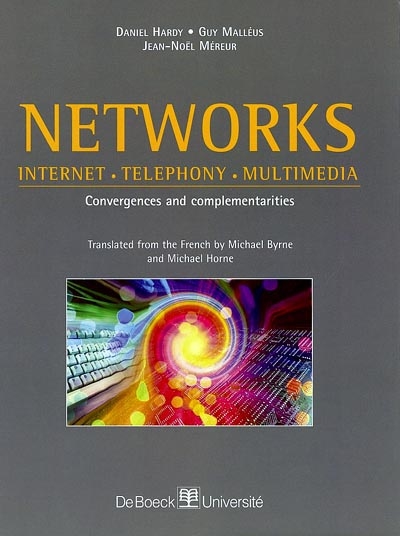en savoir plus

Permet à tous ses détenteurs d'obtenir 5% de réduction sur tous les livres lors du retrait en magasin (réduction non cumulable avec les réductions de type étudiant).
Offre également un certain nombre d'avantages auprès de nos partenaires.
Avec les favoris, retrouvez dans un espace les sélections effectuées au fur et à mesure de vos navigations dans le site.
Constituez pour votre usage personnel vos listes de livres en prévisions d'achats futurs et votre sélection d'articles, dossiers, événements, vidéos ou podcasts préférés ou à découvrir plus tard...
Il suffit simplement de cliquer sur "Ajout Favori" sur chaque page qui vous intéresse pour les retrouver ensuite dans votre espace personnel.
Requiert un compte Mollat
Requiert un compte Mollat
Networks : Internet, telephony, multimedia : convergences and complementarities
en savoir plus
Résumé
Décrit les bases et les perspectives des réseaux de télécommunications de nouvelle génération (NGN). Synthétise l'évolution juridique, détaille et précise les éléments fondamentaux des réseaux d'aujourd'hui et de demain, décrit l'existant des réseaux de transmission optique et du réseau commuté synchrone et se consacre aux NGN dans ses différentes formes. ©Electre 2025
Quatrième de couverture
This is the combined work of a team of specialists, mostly from France Telecom REtD and Cisco Systems. It describes the fundamental principles of the new generation telecommunications networks (NGNs), and discusses their likely developments.
The first part gives a general overview of the world of telecommunications: the legal context (itself evolving rapidly), the situation of service markets, what the industry has to offer in terms of products, the basic technologies and, finally, the challenges facing network operators today. It illustrates the complex path leading from technological innovation to service.
The second part deals with the key technologies of today's and tomorrow's networks, highlighting the ascendancy of digital, the contribution of optics, radio for mobility and the role of packet mode, the sine qua non of multi-speed networks. Protocols, information systems and languages are also examined at length, as are issues of traffic quality and network security.
The third part looks at the networks in use today: optical transmission networks, 64-kbps synchronous switched networks, audiovisual networks, data networks and the Internet, mobile networks and private networks. It concludes with a study of the high-speed packet mode networks now coming into existence.
The fourth and final part is devoted to new generation networks (NGNs) in their various forms, with special emphasis on the new economic context and its impact on network designers and operators. It ends with a presentation of the viewpoints of two major actors in the field.
Although of particular interest to undergraduate and postgraduate level engineering students, this work has also been made accessible to the interested layperson with no specialized knowledge of networking. Its publication coincides with the current reappraisal of the effects of the tumultuous technological changes that marked the end of the 20th century.
Fiche Technique
Paru le : 06/12/2002
Thématique : Réseaux
Auteur(s) : Non précisé.
Éditeur(s) :
De Boeck
Collection(s) : Non précisé.
Contributeur(s) : Editeur scientifique (ou intellectuel) : Daniel Hardy - Editeur scientifique (ou intellectuel) : Guy Malléus - Editeur scientifique (ou intellectuel) : Jean-Noël Méreur - Traducteur : Michel Byrne - Traducteur : Michael Horne - Préfacier : Jean-Jacques Damlamian - Postfacier : Roland Acra
Série(s) : Non précisé.
ISBN : Non précisé.
EAN13 : 9782744501449
Reliure : Relié
Pages : XVI-764
Hauteur: 28.0 cm / Largeur 22.0 cm
Épaisseur: 1.0 cm
Poids: 2865 g

